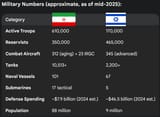Search Results
6/16/2025, 8:52:03 AM
Key Differences:
- Quantity vs. Quality: Iran has a significantly larger military in terms of personnel and some equipment categories, but much of its conventional arsenal is older and less technologically advanced due to sanctions. Israel, while smaller, boasts a highly advanced, well-trained military with cutting-edge technology, often supported by the US.
- Asymmetric vs. Conventional: Iran focuses on asymmetric warfare, including a large missile and drone program, and leverages proxy forces in the region. Israel prioritizes conventional air superiority, advanced missile defense, and rapid mobilization.
- Nuclear Ambiguity: Israel is widely believed to possess a nuclear arsenal (though undeclared), providing a powerful deterrent. Iran has enriched uranium to near-weapons-grade levels, but weaponizing it would take additional time.
Terrain Comparison:
- Iran: Iran benefits from its vast size and varied, often mountainous terrain (Zagros and Elburz mountains, large deserts). These natural barriers provide strategic depth and make a full-scale ground invasion extremely challenging, favoring defensive operations and guerrilla warfare. Control of the Strait of Hormuz is also a key strategic asset.
- Israel: Israel is a smaller nation with limited strategic depth. However, it uses its terrain to its advantage defensively. Features like the Galilee's hilly and mountainous terrain, the Jordan Rift Valley, and the Judean Mountains provide natural barriers and high ground for defense. The Golan Heights, in particular, offer significant strategic and intelligence advantages due to their elevation. Israel's compact size also allows for rapid force mobilization and efficient air defense coverage.
- Quantity vs. Quality: Iran has a significantly larger military in terms of personnel and some equipment categories, but much of its conventional arsenal is older and less technologically advanced due to sanctions. Israel, while smaller, boasts a highly advanced, well-trained military with cutting-edge technology, often supported by the US.
- Asymmetric vs. Conventional: Iran focuses on asymmetric warfare, including a large missile and drone program, and leverages proxy forces in the region. Israel prioritizes conventional air superiority, advanced missile defense, and rapid mobilization.
- Nuclear Ambiguity: Israel is widely believed to possess a nuclear arsenal (though undeclared), providing a powerful deterrent. Iran has enriched uranium to near-weapons-grade levels, but weaponizing it would take additional time.
Terrain Comparison:
- Iran: Iran benefits from its vast size and varied, often mountainous terrain (Zagros and Elburz mountains, large deserts). These natural barriers provide strategic depth and make a full-scale ground invasion extremely challenging, favoring defensive operations and guerrilla warfare. Control of the Strait of Hormuz is also a key strategic asset.
- Israel: Israel is a smaller nation with limited strategic depth. However, it uses its terrain to its advantage defensively. Features like the Galilee's hilly and mountainous terrain, the Jordan Rift Valley, and the Judean Mountains provide natural barriers and high ground for defense. The Golan Heights, in particular, offer significant strategic and intelligence advantages due to their elevation. Israel's compact size also allows for rapid force mobilization and efficient air defense coverage.
Page 1
